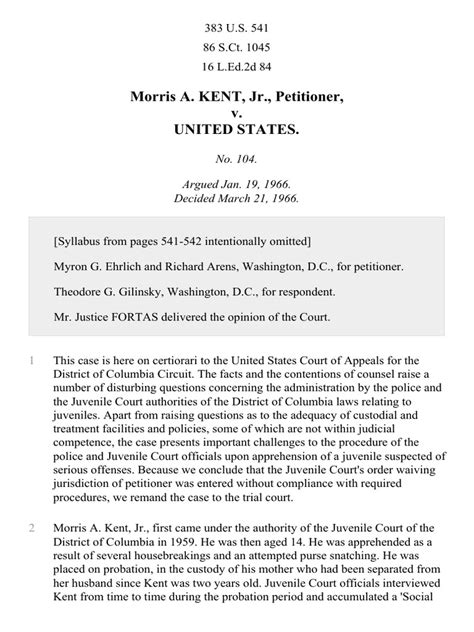Kent V United States Summary

The Kent v. United States case, decided by the Supreme Court in 1966, is a landmark decision in the realm of juvenile justice. The case involved a 16-year-old boy named Morris Kent, who was accused of rape and housebreaking. What made this case significant was the procedure followed by the Juvenile Court of the District of Columbia, which waived Kent's case to the adult court without a hearing, thereby denying him the opportunity to contest the waiver.
Background and Proceedings

The events leading to the Supreme Court’s decision began when Morris Kent, a 16-year-old at the time, was taken into custody by the police. He was accused of committing rape and housebreaking, serious offenses that could potentially lead to severe penalties, including lengthy prison sentences. The Juvenile Court, as per its usual procedure, considered whether Kent’s case should be waived to the adult court system, where he could face trial and potential sentencing as an adult. However, this decision was made without a hearing, a process that the Supreme Court would later scrutinize.
Legal Challenges and Appeal
Kent’s lawyers argued that the waiver process was fundamentally flawed because it denied Kent due process, a right guaranteed by the Constitution. They contended that the decision to try Kent as an adult should not have been made without a formal hearing, where the reasons for the waiver could be articulated and challenged. This argument was based on the principle that juveniles have the right to certain procedural protections, similar to those afforded to adults, especially when the consequences of a decision are as severe as those involved in waiving juvenile court jurisdiction.
| Key Legal Issue | Argument |
|---|---|
| Due Process | The right to a hearing before waiver to adult court |
| Procedural Protections | Equal protection under the law for juveniles |

Supreme Court Decision

The Supreme Court, in a decision written by Justice Abe Fortas, ruled that the waiver of juvenile court jurisdiction is a critically important proceeding that requires certain basic procedural safeguards. The Court held that before a juvenile is waived to the adult court system, there must be a hearing, and the juvenile must be provided with adequate notice, counsel, and an opportunity to confront and cross-examine witnesses. This ruling essentially established that the decision to try a juvenile as an adult cannot be made arbitrarily or without consideration of the juvenile’s rights and interests.
Implications and Legacy
The implications of the Kent v. United States decision were far-reaching. It led to significant reforms in the way juvenile cases are handled, emphasizing the importance of procedural due process and the protection of juveniles’ rights. The case also spurred the development of more sophisticated and nuanced approaches to juvenile justice, recognizing that minors have unique needs and circumstances that must be taken into account in the legal process.
Key Points
- The Kent v. United States case established the requirement for a hearing before a juvenile's case can be waived to adult court.
- It recognized the importance of due process and procedural protections for juveniles facing serious charges.
- The decision led to reforms in juvenile justice, emphasizing the need for a more protective and nuanced approach to handling juvenile cases.
- It underscored the principle that juveniles have the right to counsel, notice, and an opportunity to confront and cross-examine witnesses in waiver proceedings.
- The case marked a significant shift towards recognizing the unique needs and circumstances of minors within the legal system.
The Kent v. United States decision remains a cornerstone of juvenile justice, highlighting the critical importance of balancing the need for public safety with the requirement to protect the rights and interests of minors. As the legal system continues to evolve, this case serves as a foundational principle, reminding practitioners and policymakers of the need for procedural fairness and the protection of due process rights, even in the most challenging cases.
What was the central issue in the Kent v. United States case?
+The central issue was whether the waiver of juvenile court jurisdiction to the adult court system without a hearing violated the due process rights of the juvenile.
What was the significance of the Supreme Court’s decision in Kent v. United States?
+The decision established that a hearing is required before a juvenile’s case can be waived to adult court, ensuring procedural due process and recognizing the unique needs and rights of minors.
How did Kent v. United States influence juvenile justice reforms?
+The case led to significant reforms, emphasizing the importance of procedural due process, the protection of juveniles’ rights, and the development of more nuanced approaches to handling juvenile cases.



